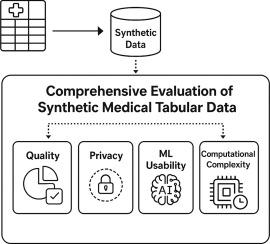A comprehensive evaluation framework for synthetic medical tabular data generation
IF 4.5
2区 医学
Q2 COMPUTER SCIENCE, INTERDISCIPLINARY APPLICATIONS
引用次数: 0
Abstract
Machine learning (ML) applications have enabled significant advancements in healthcare, such as predicting pandemics, personalizing treatments, and developing life-saving drugs. However, ML model training requires large datasets, which are difficult to obtain in healthcare due to privacy concerns. Synthetic data generation offers a promising solution by providing access to large-scale training data while protecting patient privacy. Our research focuses on tabular medical data, the predominant format for Electronic Health Records (EHRs), and introduces a comprehensive evaluation framework that assesses synthetic data in four critical dimensions: quality, privacy, usability, and computational complexity of the data generation process. The framework ensures that synthetic data maintains sufficient similarity to real data for ML applications while preserving patient confidentiality. To validate our approach, we applied six state-of-the-art (SOTA) generative models to generate synthetic medical datasets and evaluated them within our framework. In contrast to conventional approaches that focus primarily on statistical similarity, our framework provides a broader assessment that incorporates outlier detection, privacy risks, and domain-specific constraints. Our findings demonstrate that our framework can identify critical shortcomings in synthetic data generation models, such as the amplification of duplicate rows and the generation of out-of-range values, which are overlooked by traditional statistical evaluation methods. Our implementation of the framework is available at: https://github.com/akurakova/SDE_Framework

合成医学表格数据生成的综合评价框架。
机器学习(ML)应用使医疗保健领域取得了重大进步,例如预测流行病、个性化治疗和开发救生药物。然而,机器学习模型训练需要大型数据集,而由于隐私问题,这些数据集在医疗保健领域很难获得。合成数据生成提供了一个很有前途的解决方案,它在保护患者隐私的同时提供了对大规模训练数据的访问。我们的研究聚焦于表格式医疗数据,电子健康记录(EHRs)的主要格式,并引入了一个综合评估框架,从四个关键维度评估合成数据:质量、隐私、可用性和数据生成过程的计算复杂性。该框架确保合成数据与ML应用程序的真实数据保持足够的相似性,同时保护患者的机密性。为了验证我们的方法,我们应用了六个最先进的(SOTA)生成模型来生成合成医疗数据集,并在我们的框架内对它们进行了评估。与主要关注统计相似性的传统方法相比,我们的框架提供了更广泛的评估,包括异常值检测、隐私风险和特定领域的约束。我们的研究结果表明,我们的框架可以识别合成数据生成模型中的关键缺陷,例如重复行的放大和超出范围值的生成,这些都被传统的统计评估方法所忽视。我们的框架实现可以在:https://github.com/akurakova/SDE_Framework上找到。
本文章由计算机程序翻译,如有差异,请以英文原文为准。
求助全文
约1分钟内获得全文
求助全文
来源期刊

Journal of Biomedical Informatics
医学-计算机:跨学科应用
CiteScore
8.90
自引率
6.70%
发文量
243
审稿时长
32 days
期刊介绍:
The Journal of Biomedical Informatics reflects a commitment to high-quality original research papers, reviews, and commentaries in the area of biomedical informatics methodology. Although we publish articles motivated by applications in the biomedical sciences (for example, clinical medicine, health care, population health, and translational bioinformatics), the journal emphasizes reports of new methodologies and techniques that have general applicability and that form the basis for the evolving science of biomedical informatics. Articles on medical devices; evaluations of implemented systems (including clinical trials of information technologies); or papers that provide insight into a biological process, a specific disease, or treatment options would generally be more suitable for publication in other venues. Papers on applications of signal processing and image analysis are often more suitable for biomedical engineering journals or other informatics journals, although we do publish papers that emphasize the information management and knowledge representation/modeling issues that arise in the storage and use of biological signals and images. System descriptions are welcome if they illustrate and substantiate the underlying methodology that is the principal focus of the report and an effort is made to address the generalizability and/or range of application of that methodology. Note also that, given the international nature of JBI, papers that deal with specific languages other than English, or with country-specific health systems or approaches, are acceptable for JBI only if they offer generalizable lessons that are relevant to the broad JBI readership, regardless of their country, language, culture, or health system.
 求助内容:
求助内容: 应助结果提醒方式:
应助结果提醒方式:


